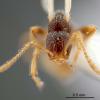The authors found that two different species of fire ants produce winged queens with different amounts of stored fat in their abdomens. The fatter ones can't fly as far, but have greater success in solitary colony founding. The lighter ones fly farther, but appear to need to enter and get accepted into an existing colony of their species to successfully reproduce. http://journals.plos...al.pone.0153955
The study targeted Solenopsis invicta & S. geminata but likely describes the situation for many other ant species, and probably is relevant to the evolution of parasitic colony founding.

















